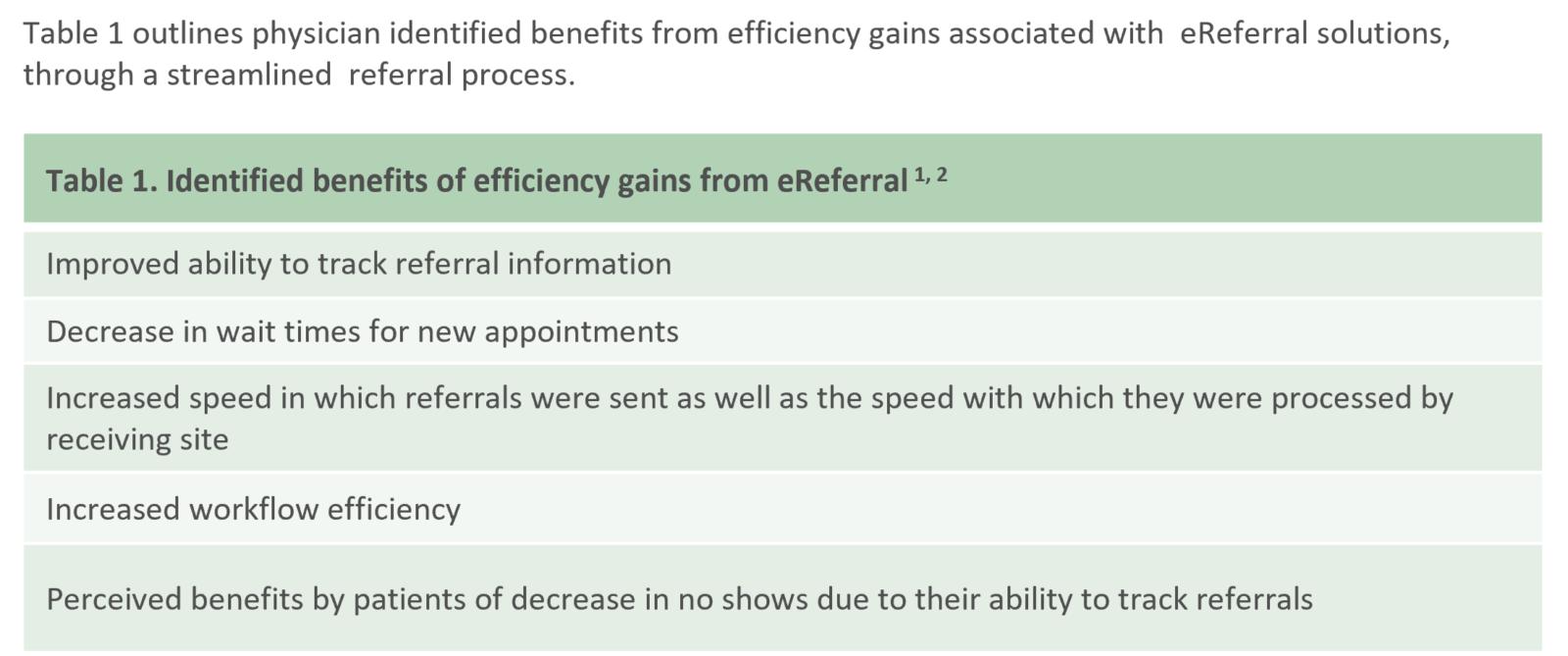Impact of eReferral on patient efficiency and likelihood of referral appointment attendance
In a study conducted in Alberta, patients noted that the convenience of tracking referral information such as appointment dates and times through email, would lead to a reduction in unnecessary phone calls to clinicians’ offices and a potential decrease in missed appointments.2 These finding suggest that eReferral can play a pivotal role in fostering patient adherence to referral appointment attendance. Patient adherence encompasses various aspects, including how well patients follow their clinicians’ advice and adhere to treatment plans such as specialist referrals.3 The introduction of eReferral solutions appears to facilitate some of these factors by enhancing communication and coordination between patients and healthcare providers.

Key takeaways
Improved efficiency with the implementation of eReferral, has positively impacted referral appointment attendance.
Efficiency and Patient Adherence
To investigate the impact of eReferral (electronic referral) on the patient experience, in-depth interviews were conducted with five patients. The patients experienced eReferrals from their primary care physicians for various medical appointments, including breast mammography, ultrasounds, and mental health therapy. Patients expressed the significance of patient adherence to referral appointments as related to the more efficient process of eReferral.
One patient shared their experience, highlighting the convenience it brought to their routine breast ultrasounds, which were required every six months. Through eReferral, their primary care physician seamlessly scheduled ongoing appointments without requiring the patient to visit the office. Instead, the patient received appointment details via email, eliminating the need for time-consuming phone calls to obtain confirmation information. The patient explained how eReferral not only improved efficiency but also contributed significantly to their referral appointment attendance for their biannual appointments. Knowing that appointment details arrived via email, it provided them peace of mind and reassurance that necessary care would seamlessly continue.
Several patients also emphasized that the efficiency of eReferral; it not only improved their engagement and empowerment but also enabled healthcare professionals to dedicate more of their time to delivering high-quality care rather than being weighed down by administrative tasks related to referral communication.
Patients were keenly aware of the difficulties and challenges associated with reaching their respective clinician’s office by phone. They recognized that eReferral allowed their primary care offices to significantly reduce the volume of phone calls from patients inquiring about appointments, freeing up valuable resources to concentrate on patient-facing responsibilities.
The qualitative in-depth interviews with patients are consistent with the findings from the patient experience survey noting high satisfaction among patients (n= 27,354):
Without eReferral method it takes longer, it’s confusing, doctor’s office calls in a rush… sometimes you just show up even if unsure if appointment time and date is correct, so more likely to miss appointments.
Patient
Diagnosed with breast cancer
1Azamar-Alonso, A., Costa, A. P., Huebner, L.-A., & Tarride, J.-E. (2019). Electronic referral systems in health care: a scoping review. Clinicoecon Outcomes Res, 11. https://www.ncbi.nlm.nih.gov/pmc/articles/PMC6511625/
2Health Quality Council of Alberta. Patient Perspectives on an Electronic System for Alberta. (2016) Retrieved October 20, 2023.
3Panahi, S., Rathi, N., Hurley, J., Sundrud, J., Lucero, M., & Kamimura, A. (2022). Patient Adherence to Health Care Provider Recommendations and Medication among Free Clinic Patients. Journal of Patient Experience, 9).
Interested in learning more?
Interested in partnering with us or learning more about
what we can offer you? Please reach out here.
Get the latest resources and insights
-

Plain Language Description: Ocean eReferral to Cerebrum EMR
Amplify Care and AwareMD (a WELL Health Company) have partnered to allow healthcare clinicians to…
-

Triaging Referrals to eConsult (TReC)
TReC is a workflow that allows specialists to respond to referrals with advice, through an…
-

How AI scribes enable better interactions with patients during appointments
AI scribes are improving patient-clinician interactions by reducing administrative tasks, allowing clinicians to be more…
-

Fiscal year 21/22 eReferral highlights
eReferral deployment across Ontario, led by the Ontario eServices Program, resulted in a large degree…